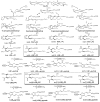Generation and detection of levuglandins and isolevuglandins in vitro and in vivo
- PMID: 21705973
- PMCID: PMC6264246
- DOI: 10.3390/molecules16075333
Generation and detection of levuglandins and isolevuglandins in vitro and in vivo
Abstract
Levuglandins (LGs) and isolevuglandins (isoLGs), formed by rearrangement of endoperoxide intermediates generated through the cyclooxygenase and free radical induced oxidation of polyunsaturated fatty acids (PUFAs), are extraordinarily reactive, forming covalent adducts incorporating protein lysyl ε-amino groups. Because they accumulate, these adducts provide a dosimeter of oxidative injury. This review provides an updated and comprehensive overview of the generation of LG/isoLG in vitro and in vivo and the detection methods for the adducts of LG/isoLG and biological molecules in vivo.
Figures




Similar articles
-
Isolevuglandins covalently modify phosphatidylethanolamines in vivo: detection and quantitative analysis of hydroxylactam adducts.Free Radic Biol Med. 2009 Dec 1;47(11):1539-52. doi: 10.1016/j.freeradbiomed.2009.09.003. Epub 2009 Sep 12. Free Radic Biol Med. 2009. PMID: 19751823 Free PMC article.
-
Levuglandins and isolevuglandins: stealthy toxins of oxidative injury.Antioxid Redox Signal. 2005 Jan-Feb;7(1-2):185-201. doi: 10.1089/ars.2005.7.185. Antioxid Redox Signal. 2005. PMID: 15650407 Review.
-
New developments in the isoprostane pathway: identification of novel highly reactive gamma-ketoaldehydes (isolevuglandins) and characterization of their protein adducts.FASEB J. 1999 Jul;13(10):1157-68. doi: 10.1096/fasebj.13.10.1157. FASEB J. 1999. PMID: 10385607 Review.
-
Isolevuglandin adducts in disease.Antioxid Redox Signal. 2015 Jun 20;22(18):1703-18. doi: 10.1089/ars.2014.6154. Epub 2015 Feb 18. Antioxid Redox Signal. 2015. PMID: 25557218 Free PMC article. Review.
-
Iso[7]LGD2-protein adducts are abundant in vivo and free radical-induced oxidation of an arachidonyl phospholipid generates this D series isolevuglandin in vitro.Chem Res Toxicol. 2004 May;17(5):613-22. doi: 10.1021/tx034185+. Chem Res Toxicol. 2004. PMID: 15144218
Cited by
-
Formation of Oxidatively Modified Lipids as the Basis for a Cellular Epilipidome.Front Endocrinol (Lausanne). 2020 Dec 21;11:602771. doi: 10.3389/fendo.2020.602771. eCollection 2020. Front Endocrinol (Lausanne). 2020. PMID: 33408694 Free PMC article. Review.
References
-
- Davies S.S., Amarnath V., Montine K.S., Bernoud-Hubac N., Boutaud O., Montine T.J., Roberts L.J., 2nd Effects of reactive gamma-ketoaldehydes formed by the isoprostane pathway (isoketals) and cyclooxygenase pathway (levuglandins) on proteasome function. FASEB J. 2002;16:715–717. doi: 10.1096/fj.01-0696fje. - DOI - PubMed
Publication types
MeSH terms
Substances
LinkOut - more resources
Full Text Sources

